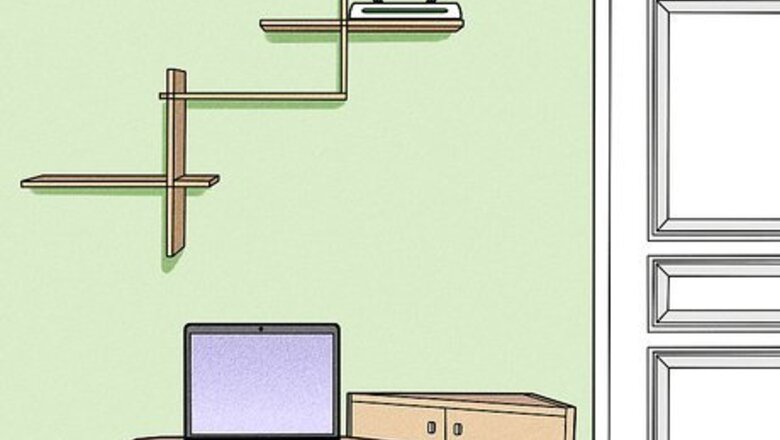
views
Keep the router on a shelf.
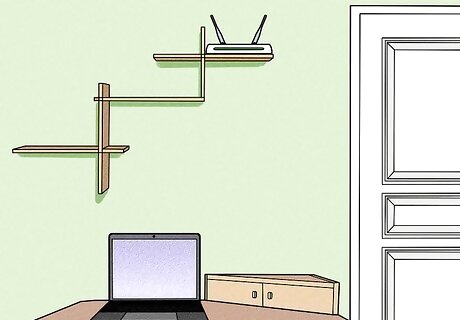
Routers send signals better to things that are below them. Routers aren’t great at sending signals upward, so look for a place that’s elevated off the ground to keep your router. Somewhere like a countertop or top shelf of a bookcase both work great for routers. Make sure your router is only surrounded by open-air so it doesn’t overheat and provides the strongest wifi.
Move objects away from your router.

Anything between your router and device weakens your signal. Objects that cause the most interference with your wifi network include concrete, metal, cordless phones, and microwaves. Even wood, water, and brick can absorb your wifi signal and reduce the range. When you’re placing your router, avoid putting it on the floor, next to a window, or near an exterior wall. Check that there’s nothing directly next to the router so you don’t weaken the signal. Avoid storing your router inside of a closed cabinet. Whenever you use wifi, keep any doors open between you and the router to help improve your signal.
Point the antennas up.
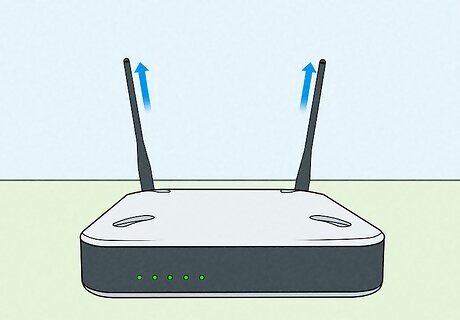
Try this for more even coverage if your router has external antennas. Antennas help direct your wifi signal, but you’ll get less strength in any other direction. Bend the antenna so it points straight up to make the signal spread evenly throughout your home. If that doesn’t work, just try turning the antenna toward the weak spot to see if the range improves. If your router doesn’t have an external antenna, you may be able to buy one and plug it into your router to help improve the signal. Check electronics stores or online to see what’s available.
Disconnect unused devices.
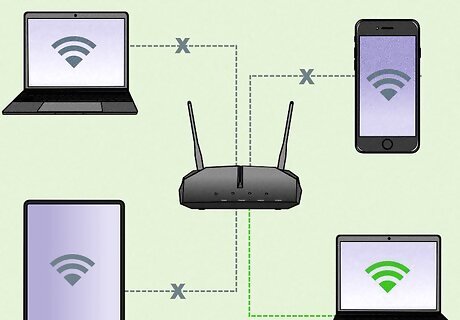
The devices connected to the Internet use up your router’s bandwidth. Make sure all of the devices you aren’t using are completely turned off so they’re not eating up your wifi signal. When you’re finished, try connecting to your wifi again to see if you get better performance. You can also log in to your router on a computer to see all of the connected devices and remove the ones you don’t want on the network. If you don’t recognize the devices connected to your router, someone else may have logged into your wifi and is using your Internet. Remove the devices and immediately change to a stronger password.
Place your router in a central location.

Routers near exterior walls won’t have as much range and coverage. Try to put your router in the main area of your home so it’s unobstructed and able to send a strong signal in all directions. Run a long ethernet cable to the wall port or modem to plug it back in. When you first get your router, the technician setting it up will usually help you find the most effective spot to keep it. If you mainly use wifi in a media room, try placing the router there instead so you have the strongest, most consistent signal. In a 2-story home, keep the router on the first floor close to the ceiling so your entire home gets the best signal.
Place foil on one side of the router.
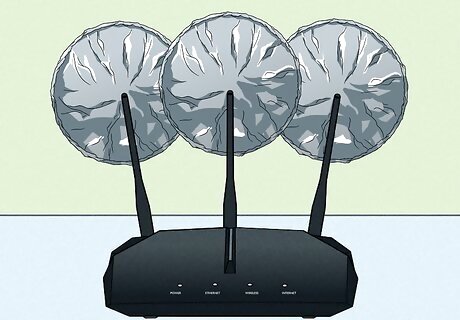
Foil reflects your wifi signal in the direction you want it to go. Wrap a piece of aluminum foil around something rounded, such as a water bottle or a soda can, to help shape it. Remove the piece of foil and set it vertically on one side of the router to prevent the signal from going in that direction. Your wifi will reflect off of the aluminum foil and possibly increase the range and speed of your network. For example, if you don’t want your wifi signal absorbed by a wall or window, set the foil between it and your router.
Plug in a wifi extender.
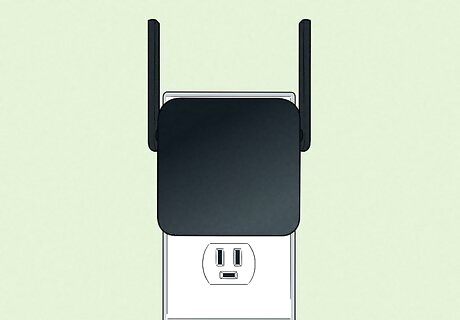
Wifi extenders amplify your router’s signal to a wider area. You can buy a wifi extender online or from any electronics store. Plug the extender into a wall plug in a spot that’s close to where you’re having trouble but still has a good signal. Connect your computer or mobile device to your wifi network as normal. The extender will capture your wifi signal and spread it out even further so you’re able to connect no matter where you are in your home. If you place an extender somewhere that already has a weak signal, you still may have slow speeds while you’re browsing the web.
Change to a 2.4 GHz frequency.
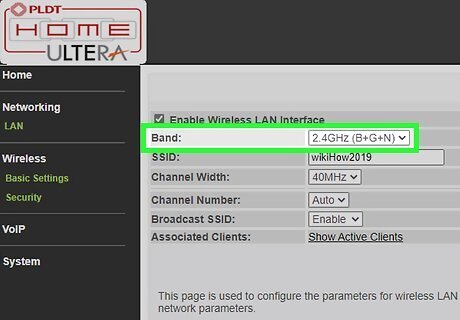
A 2.4 GHz frequency passes through walls easier and increases range. Most routers have 2.4 and 5 GHz frequencies that you can connect to separately. Check the available wifi networks your device can connect to and select the one labeled “2.4.” If you don’t see it listed, log into your router settings on a web browser using the address on the back of your machine. Manually change the frequency to 2.4 GHz for more reliable speeds and range. While 5 GHz gives you a stronger signal, it doesn’t travel through walls or ceilings as well, so it doesn’t give you the best range.
Change the wifi channel.
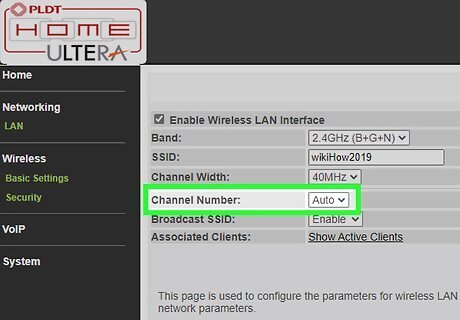
Other nearby wifi networks can cause interference on the same channel. Log into your router on a browser window using the IP address on the back or bottom of the machine. Look through the settings for the wireless channel information. Look through the list of available channels and select a different one than the one you’re currently connected to. Test using your device again to see if there’s a noticeable improvement to your wifi. Try the rest of the channels on the list to see which one works the best for you. The location of the channel menu depends on the router you’re using. Your router will usually try to connect to the strongest channel automatically. You can run a wireless scan on your computer to find the channels that are the strongest.
Update your router’s firmware.
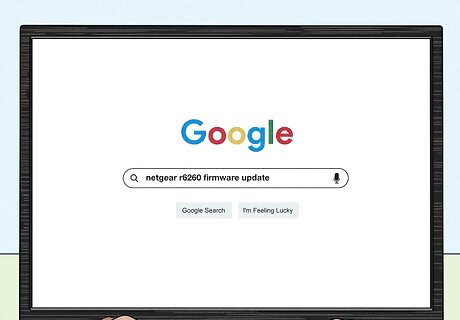
Firmware updates might improve your router’s overall performance. Search online for your router’s model to see if there are any updates listed on the manufacturer’s website. If you find an update, log in to your router on a new browser window and find an option labeled “Firmware Updates” or something similar. Install the file on your router and let it update completely before trying out your wifi again.
Try rebooting your router.

A hard restart refreshes your router so it works better. Turn off the device you’re trying to connect to your wifi. Then, unplug your router from power and leave it alone for at least 30 seconds so it completely powers down. Plug your router back in and let it boot up, which may take a couple of minutes. Turn your device back on and try connecting to your wifi again to see if the range improved. If your modem and router are separate from one another, unplug your modem before the router. Let the modem boot up completely before plugging your router back in.
Switch to a mesh wifi system.
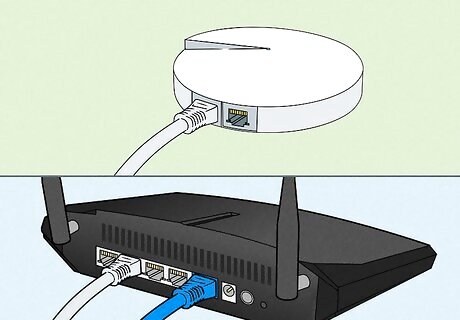
Mesh systems use multiple routers to make a consistent signal. Get a mesh wifi system from your local electronics store. Plug one of the mesh system devices into the back of your router to connect it to your network. Place the remaining mesh devices throughout your home wherever you’re having trouble connecting to the Internet. The mesh devices all give off full-strength signals to make your wifi network larger and more reliable. Mesh wifi systems usually cost around $100–200 USD.
Get a new router.
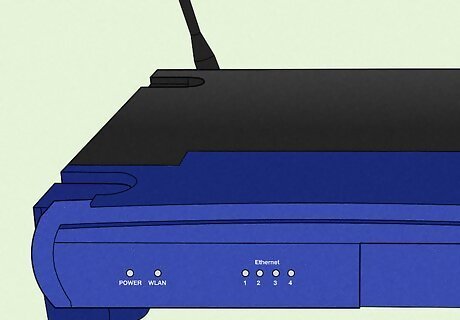
Older routers don’t perform as well as newer models. Start by reaching out to your Internet service provider and asking if there are any updates or new router models they can provide you. If they don’t have anything to offer, visit an electronics store and look for a router labeled “802.11ac” or “802.11ax” since they’re the most current and reliable. Connect your new router to your modem and set up your network.




















Comments
0 comment